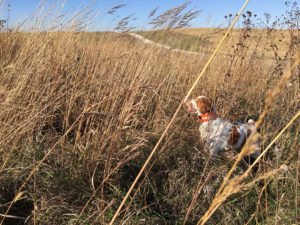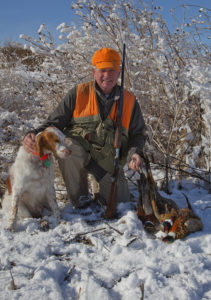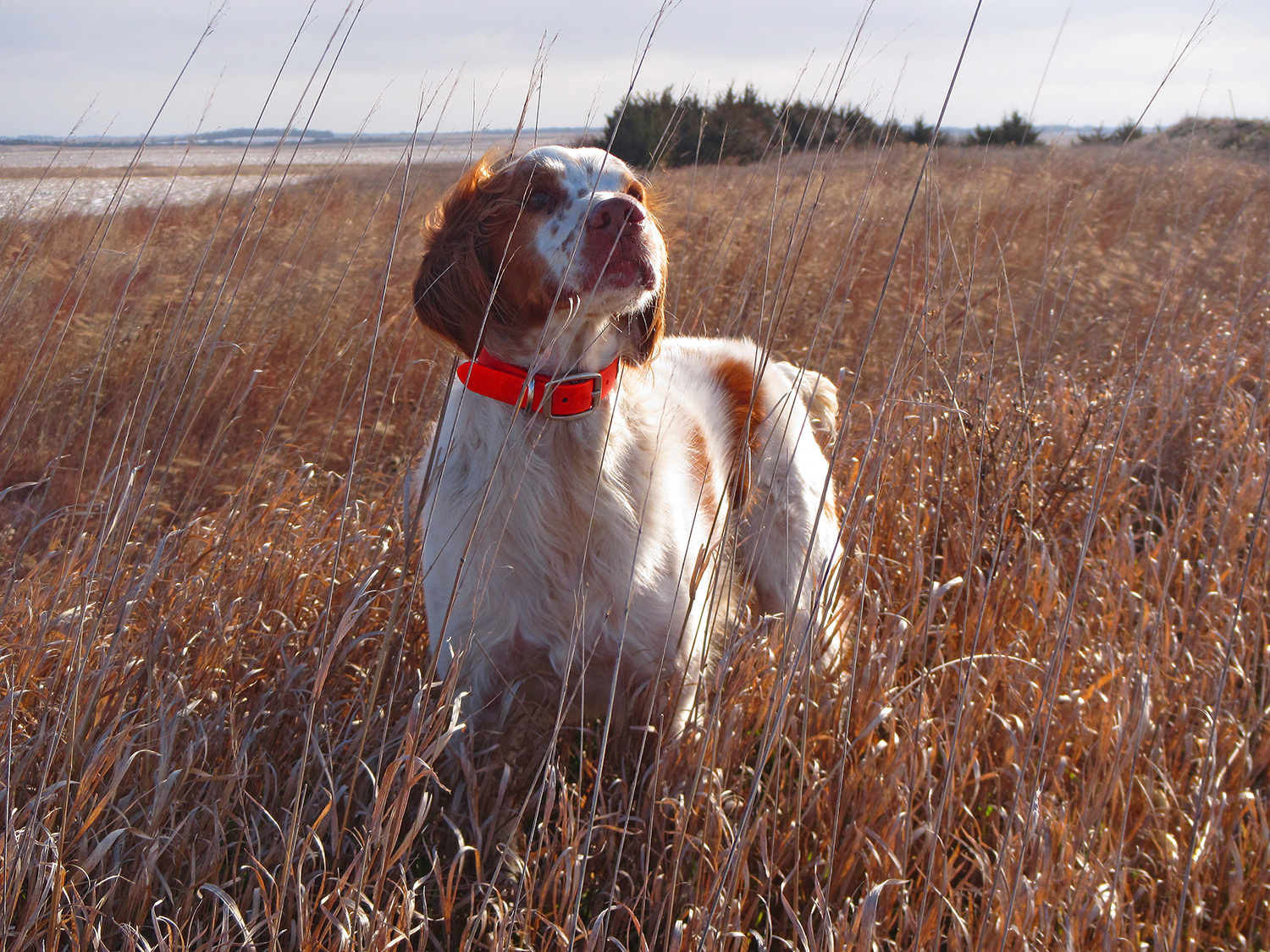This afternoon, Flick joined his predecessors on the other side. The spirit was willing, but his hips finally gave out. As I mourn his passing, I remember the companions who came before him. They were far better at being dogs than I am at being a person. I miss them . . .
IT’S MADE OF BRASS, ABOUT THE DIAMETER OF A SILVER DOLLAR WITH A NYLON STRAP LOOPED THROUGH THE TOP SO IT CAN BE STRUNG ON A COLLAR. It has no markings, but the catalog house that sold it to me, many years ago, said it came from England— certainly, it has that English look and feel, an exquisite bit of craftsmanship from another time that combines simplicity, elegance, and dependability to do a job that is largely irrelevant in the modern age. It has a bright, clear tenor voice, not loud but surprisingly penetrating, even on a day when the first cold front of November is hurrying across the prairie, tousling the bluestem as it passes.
I must have bought it around 1987. I was starting Britt at the time. He was the most talented bird dog I’ve ever owned, and he was just starting to show his worth when we encountered the Conservation Reserve Program. We were used to working fencelines and shelterbelts, long strips of cover Britt could hunt from the outside. When he went on point, he was nearly always out in the stubble where I could see him. The bird might not hold, but there was at least no problem finding the dog.
The first CRP field we hunted was a full section of switchgrass just reaching maturity. Some of the seed heads were eight feet off the ground; the vegetation below was almost impenetrable. We both saw the potential and dived into the jungle with high expectations. I saw Britt’s wake for the first fifty yards, then the grass was still. I stopped to listen for him. Not a whisper. I figured he was within sixty yards of me, almost certainly pointing a pheasant, and there was no way I was going to call him off that point.
I started a spiral search pattern, and in about five minutes, I found him, still holding, but with the relaxed tail that told me the scent had gone cold. The rooster had quietly departed for other hiding places.
By the time that field had finished with us, I could see that Britt and I needed some way of keeping track of each other if we intended to hunt any more CRP. The first generation of beeper collars had just been invented, but fresh out of college, I didn’t have the money to buy one, and I didn’t really want one anyway— that infernal beeping felt a little like spray-painting graffiti on the Mona Lisa. So I bought the bell.
We went back to that section of CRP on a clear, quiet morning with the temperature hovering around five. The frost lay like snow on the grass— I figured Britt would be able to smell a rooster from a quarter-mile away. He skirted the edge of the heavy grass for a hundred yards before a plume of scent lured him into the cover, and listened as the bell traced his progress, out and across the lee of a low rise. Then, suddenly, nothing, a hole in the air where the clear tink-tink had been. I headed toward the last place I had heard the sound, holding the shotgun high enough to keep the grass stems out of my eyes.
I almost stumbled over him, head high, stub tail at full attention, taut as a violin string. One more step and the rooster came straight up, clawing into the blue sky with a clatter and a squawk, his flanks like molten copper in the first light.
Taken by surprise, as I nearly always am when a rooster flushes, I missed with the first barrel but managed to catch him with the second. Britt disappeared into the switch, the bell marking his progress, farther away, farther, then a pause, closer, closer still, and suddenly, two amber eyes out of the wall of grass— Britt with the bird.
OVER THE NEXT TEN YEARS, the two of us spent a lot of time in this strange, one-way telecommunication, Britt transmitting out of sight while I tried to interpret the message. I could tell a lot by the sound of the bell. There was a steady cadence with a syncopated flourish when he was quartering, looking for scent. When something caught his attention, the cadence broke, and the irregular notes of the bell signaled every move of his head. There was a Doppler change in the tone as he worked— higher as he came back toward me, lower as he went away. Early in his career, he was fond of pointing meadow voles, and I could often tell by the bell that his tail was wagging as he pointed, a sign that he was mousing. And now and then, that hole in the air, the sudden silence— a rooster, a covey, a band of chukars, a ruffed grouse, a blue, a bomber. We hunted them all, Britt following his unerring nose while I followed the bell.
One evening, the friend who had told me about Britt’s litter called me about another litter in the same line, so on the way to a quail hunt in the Flint Hills, I stopped to look the pups over. That was how little Meg came to our house.

Flick in the tall stuff with a bird holding tight. Wrong move for the pheasant . . . (Photo by Chris Madson, copyright 2019).
Britt tolerated her, and she paid him the respect due to his age and experience. They hunted together for two seasons before she inherited the bell. She might not have had the talent of her great uncle, but she was still a better bird dog than I deserve. I remember her pointing a pheasant on the slope of one of those huge prairie swales that break up the high plains, staunch in the wine-colored little bluestem as my partner walked in. The rooster flushed wild, and the shot rocked him but didn’t break a wing. We watched and Meg watched as the bird flapped and glided, flapped and glided down the long slope, across the creek bed, and up the other side, almost to the horizon before he sat down.
My eyes dropped back to another movement, Meg crossing the creek bed on line. She trotted up the long slope on the far side, a tiny white speck by this time, paused on the hilltop, then turned back toward us. As she crossed the creek bed, I could see she was carrying something. She disappeared in the grass on our side, and a long minute passed before I heard the bell approaching. She walked up to me with the bird in her mouth. I took it and scratched her ear. Good dog; good dog.
The two of us chased many birds across many states to places I don’t think I would ever have seen on my own: the pocket just under the rim of Tatman Mountain in northern Wyoming where a tiny spring waters a lush stand of wild rye and a perennial covey of Huns and you can see for fifty miles. The terrace in Iowa where there is always a rooster and Meg once pointed the biggest whitetail buck I’ve ever seen, caught napping in the switchgrass. The prairie slope out over the Missouri River in North Dakota with its sharptails, the buffaloberries scarlet on the hillside and the hawthorn fruit fuschia against the gray branches in the draw.
The moments fade in the telling, like picked wildflowers, but in my head they are forever bright against the background of the autumns we shared, the collection of days stitched together by the play of light and shadow on the grass, the sigh of the wind, and the tinkling of a small bell.
NOT LONG AFTER MEG PASSED HER FOURTEENTH BIRTHDAY, a friend invited us to hunt his farm in western Iowa. The farm reflects Tom’s commitment to conservation— terraces, grassy waterways, and buffer strips to keep the topsoil in place; blocks of conservation reserve to rebuild topsoil where it’s been lost; and wetland reserve to purify the runoff. That kind of management produces pheasants even when the surrounding farms have been scalped for profit.
Meg was still good for two hours in the morning, and while her pace had slowed, her enthusiasm for the game was as bright as ever. On the morning of the fifth day, I was packing to leave, one bird short of Iowa’s possession limit. Always the gracious host, Tom told me to stop and check one last hillside on my way to the interstate, so I headed south, Meg riding shotgun in the pickup, marking every meadowlark as it flushed off the side of the road.
The CRP Tom has recommended was a perfect corner for pheasants— bluestem and switchgrass with a mix of broad-leafed plants just below a harvested cornfield. I Unbuckled Meg’s collar and slipped on the bell before I lifted her out of the truck, then grabbed the Model 12 and followed her down the fencerow. She disappeared into the grass, and I waited, listening to the bell as it made its invisible way down the slope. A hundred yards from the truck, it stopped.
I walked that way and found her just a couple of yards into the heavy cover, rock solid. As I passed her ear, two roosters exploded out of the grass. I picked the left bird and crumpled it. Meg Disappeared. Then, I saw her coming back through the short brome of the field edge, tail and head up, with the rooster in her mouth, the light of the December morning warm on them both. A fine way to end a hunt, I thought, and a season.
At the time, I couldn’t know that it was also the end of a career. That Iowa rooster was Meg’s last bird.

The last day of the Nebraska pheasant season. Three birds from three perfect points. (Photo by Chris Madson, copyright 2019).
AND SO THE BELL PASSED TO FLICK. He’s eighteen months old now, with two seasons under his belt, a passion for rabbits, and a talent for birds. He’s presided over the demise of about fifty pheasants already, and just last week, I had a chance to introduce him to some Kansas bobwhite. He didn’t know what to make of the first covey, but he quickly filed the scent under the general heading of “game,” trotted down the edge of the milo field to a thicket of sand plum and pointed a single. Which I promptly missed.
As I strolled along behind my new companion toward the next covert, it occurred to me that a bird hunter measures his life in dogs. With luck, I may have one more after Flick. Or he may be the last. Such thoughts can lead out into areas of metaphysics and theology I’m not qualified to navigate. Is there another world beyond the pale? I’m sure I don’t know. But I find it hard to imagine a place much better than the one we were all born to, this small blue planet where life has gathered against all the odds.
I’m not anxious to leave. If I were given a choice between crossing over into an unknown paradise or melting back into the ground of this one, I think I’d just as soon stay. Still, there is the possibility that, when the time comes, the fields on the other side will be drenched in the morning sun of November with the scent of fall on the breeze . . . and the sound of a small brass bell, fading toward the horizon.
And, if that’s the call, I just might have to follow.
—————-

Leave a Reply
You must be logged in to post a comment.